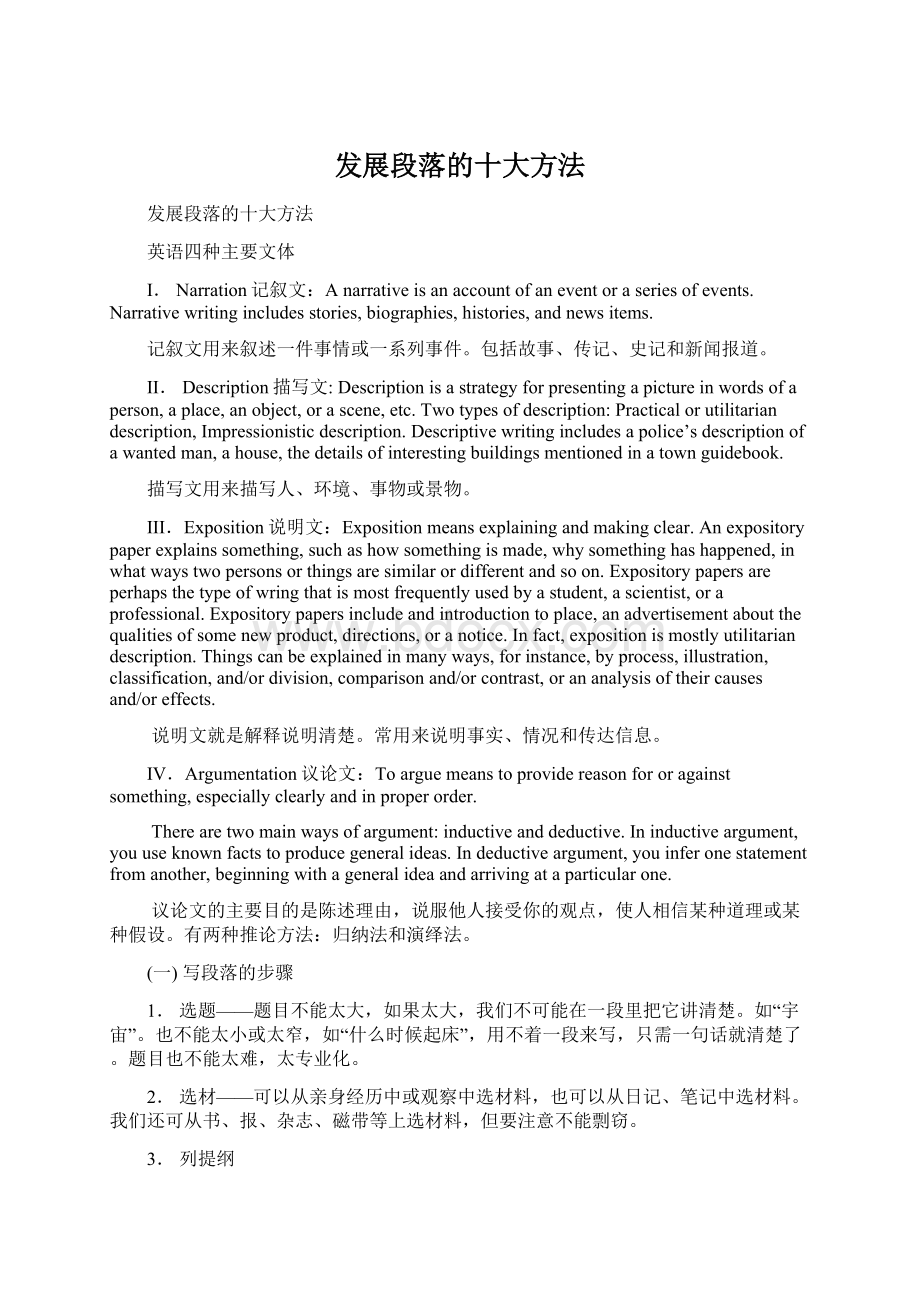发展段落的十大方法.docx
《发展段落的十大方法.docx》由会员分享,可在线阅读,更多相关《发展段落的十大方法.docx(13页珍藏版)》请在冰豆网上搜索。

发展段落的十大方法
发展段落的十大方法
英语四种主要文体
I.Narration记叙文:
Anarrativeisanaccountofaneventoraseriesofevents.Narrativewritingincludesstories,biographies,histories,andnewsitems.
记叙文用来叙述一件事情或一系列事件。
包括故事、传记、史记和新闻报道。
II.Description描写文:
Descriptionisastrategyforpresentingapictureinwordsofaperson,aplace,anobject,orascene,etc.Twotypesofdescription:
Practicalorutilitariandescription,Impressionisticdescription.Descriptivewritingincludesapolice’sdescriptionofawantedman,ahouse,thedetailsofinterestingbuildingsmentionedinatownguidebook.
描写文用来描写人、环境、事物或景物。
III.Exposition说明文:
Expositionmeansexplainingandmakingclear.Anexpositorypaperexplainssomething,suchashowsomethingismade,whysomethinghashappened,inwhatwaystwopersonsorthingsaresimilarordifferentandsoon.Expositorypapersareperhapsthetypeofwringthatismostfrequentlyusedbyastudent,ascientist,oraprofessional.Expositorypapersincludeandintroductiontoplace,anadvertisementaboutthequalitiesofsomenewproduct,directions,oranotice.Infact,expositionismostlyutilitariandescription.Thingscanbeexplainedinmanyways,forinstance,byprocess,illustration,classification,and/ordivision,comparisonand/orcontrast,orananalysisoftheircausesand/oreffects.
说明文就是解释说明清楚。
常用来说明事实、情况和传达信息。
IV.Argumentation议论文:
Toarguemeanstoprovidereasonfororagainstsomething,especiallyclearlyandinproperorder.
Therearetwomainwaysofargument:
inductiveanddeductive.Ininductiveargument,youuseknownfactstoproducegeneralideas.Indeductiveargument,youinferonestatementfromanother,beginningwithageneralideaandarrivingataparticularone.
议论文的主要目的是陈述理由,说服他人接受你的观点,使人相信某种道理或某种假设。
有两种推论方法:
归纳法和演绎法。
(一)写段落的步骤
1.选题——题目不能太大,如果太大,我们不可能在一段里把它讲清楚。
如“宇宙”。
也不能太小或太窄,如“什么时候起床”,用不着一段来写,只需一句话就清楚了。
题目也不能太难,太专业化。
2.选材——可以从亲身经历中或观察中选材料,也可以从日记、笔记中选材料。
我们还可从书、报、杂志、磁带等上选材料,但要注意不能剽窃。
3.列提纲
4.写初稿
5.修改
(二)发展段落的十大方法
1.按时间先后顺序发展段落
写传记、讲故事、写游记、讲真事时,往往先讲先发生的事,后讲后发生的事。
用这一方法安排的段落就是按时间先后顺序发展段落。
按时间先后顺序发展的段落可以有主题句,也可没有主题句;可以有结尾句,也可没有结尾句。
下面就是一个既无主题句也无结尾句的传记性的段落。
JackLondon,oneofthegreatestofAmericancriticalrealists,wasborninSanFrancisco,CaliforniaonJan.12,1876.HespenthischildhoodonCaliforniaranchesandthestreetsofOakland.Afterhefinishedgrammarschool,hewasputintoacannery,whereheoftenhadtoworklonghours.Laterhebecameanoysterpirate,asailor,aworkerinajutemill,astokeratapowerplantandforaperiodoftime,atramp.In1896,aftersomepreparatorystudy,heenteredtheUniversityofCaliforniaonmoneyborrowedfromhissister,butwassoondrivenbypovertytogiveuphisstudies.Inthesameyear,hejoinedtheSocialistLabourParty,theactivitiesofwhichwerelimitedtotheoreticaldiscussionsandpropagandawork.In1897,whengoldwasdiscoveredintheKlondike,21-year-oldLondonwenttheretoworkasagoldminer.Havingspentafreezing,fruitlesswinterintheFarNorth,hereturnedtoOaklangdtowrite.In1900hiscollectionofshortstoriesThesonofthewolfwaspublishedbyHoughtonMifflin.Then,in1903,camehisbest-sellingnovelTheCalloftheWildandthebeginningoftheyearsthatweretobringhimwealthandworldwidepopularity.TheseaWolfwaspublishedin1904andthatsameyearhewentasawarcorrespondenttoJapan.Laterundertheinfluenceofthe1905RevolutioninRussia,Londoncameintoclosercontactwiththeworkingclassmovementandbegantotakeanactivepartinsocialistactivities.Duringthisperiodhereachedtheheightofhiscreativeactivities,producingsuchworksasThePeopleoftheAbyss,ThewaroftheClasses,TheRevolution,TheIronHeel,andMartinEden.After1910,Londongraduallylefttheworkingclassmovement.HealsowenttoMexicoin1914,cruisedtheCaribbeanandsailedhisownketchtotheSolomonsbeforehisdeathin1916.
这段提纲挈领地叙述了London从1876年出生到1916年去世整整40年的生平事迹。
段落是按时间先后顺序写的。
2.按空间顺序发展段落
3.用讲述过程或步骤的方法发展段落
PreparingforFinalExaminations
Theprocessofpreparingforendofyearexaminationsinvolvesbothlong-rangandshort-rangeplanning(TopicSentence).Basiclong-rangeconsiderationsareregularclassattendanceandinsistence,week-by-weekcompletionofallreadingassignments.Ofcourse,systematicnotesofmajorpointsraisedintheclassdiscussionsorintheassignedreadingsprovideacondensedrecordoftheessentialfactsandconcepts.Tokeepoutlinesandnotesuptodate,theyshouldbereviewedandrevisedfromtimetotimethroughoutthecollegeyear.Short-rangeplanningshouldincludecollectingcopiesofpreviousexaminationsorsuggestedstudyquestionsatleastthreeweekspriortotheexamdate.Thesecanbeusedasguidesinanintensivereviewoftheideasthatteachershaveconsideredimportant.Self-confidenceinanalyticalandcompositionalskillcanbeincreasedbyactuallywritingoutandcheckingpracticeanswerstotypicalexaminationquestions.Finally,inadditiontopreparingthemind,careshouldbetakentoensurethatthebodyiswell-restedandnervescalmattheactualtimeofexamination.Fromtheforegoing,itshouldbeclearthateffectivepreparationforfinalexaminationisreallyayear-longprocessrequiringthecontinuoususeofappropriatestudytechniques(concludingSentence).
4.用举例说明的方法发展段落
5.用分类的方法发展段落
用分类的方法发展段落就是要根据某种(些)原则把人物、看法、事情、地方等分成若干类(种、组)。
在一段里,可以根据一个原则把人、物、看法、事情、或地方分成若干类。
譬如,可以根据性别把人分为男人和女人。
在这样的段落里,每一类就是一个直接支撑句。
在每一个直接支撑句后,可以有一个或多个间接支撑句来说明那一类别。
在一段里,我们可以根据多个标准把人、物、看法、事情、或地方分成若干类。
譬如,根据性性别,人可以分成男人和女人;根据年龄,人可以分为婴儿、小孩、青年人、中年人、老年人;根据职业,人可以分为工人、农民、工程师、教员、医生、护士、军人、学生等;根据肤色,人可以分为黑种人、红种人、白种人、黄种人等。
在这样的段落里,每一种分法就是一个直接支撑局。
在一个直接支撑句后,可以有一个或多个间接支撑句来说明那种分法。
不管怎样分类,有一点要记住:
用同一中方法分出来的各类之间不应发生重叠。
进行分类的段落的结构通常是:
主题句——支撑句——结尾句。
可用这样的句子来作主题句:
…canbeclassifiedindifferentways;…maybesortedinto…categoriesaccordingto…;mightgroup…into…;…mayclassify…..onthebasisof…;…usuallyfallinto…groups;…canebroughtunderthreechiefcategories;…maybeclassedinfivegroups等。
支撑句应象上一段讲的那样,根据不同分法而有变化。
结尾句同其他段落结尾句相似,用来进行总结、评论、重复主题等。
现在,请看下面这一示范段落。
TheClassificationofParagraphs
Individualparagraphs------thebuildingblocksofessays,articles,chapters,andotherlongerpapers------maybeclassifiedinavarietyofways.Attheessaylevel,paragraphmaybesortedintofunctionalgroupssuchasintroductory,developmental,transitional,summarizing,andthelike.Dependinguponthepurposeorintentofthewriter,particularparagraphsmaybethoughtofasaimingtopersuade,inform,argueorexcite.Paragraphsmayalsobeclassifiedaccordingtosuchtechniquesofdevelopmentascomparison,contrast,anddefinition.Suchclassificationsmakeitpossibletotalkaboutalargenumberofparagraphsbygroupingthemintoasmallnumberofclasses.
为了使分类段落更好地关联,我们可以用First,second,third,also,besides,last,finally,Thefirsttypeis…,Thesecondtypeis…等关联词语。
此外,重复关键的词语也可使段落有连贯性。
6.用比较/对照的方法发展段落
我们用比教/对照的方法发展段落以便弄清两个人、两个东西、两种方法、两个地方等有哪些相似之处或不同之处。
用比较/对照的方法发展的段落模式为:
主题句——支撑句——结尾句。
如果我们用比较的方法(bycomparison)发展段落,就应在那一段里显示两人、两物、两地等在哪些方面相似。
这种段落的开头常用“AlthoughChongqingandWuhanareintwodifferentprovinces,theyaresimilarinmanyways.”或“Inspiteoftheirdifferenceinlength,anessayandaparagrapharequitealikestructurally.”和“MostpeoplebelievethatAandBhavethreethingsincommon.”这样的句子作为主题句。
为了把相似之处讲清楚,需要恰当的2安排支撑局。
在这方面,有几个常用的模式可供我们选用。
一是“A1,A2,A3…+tr(transitiona)+B1,B2,B3…”模式。
我们一重庆和武汉的相似此处为例,解释这一模式。
假定重庆为A,武汉为B。
在段落的第一个支撑句里,写重庆的地理位置。
在第二个支撑句里,写重庆的天气。
在第三个支撑句里写重庆的工业。
总之,前面几个支撑句都是关于重庆的。
然而,写一个过渡句,表示我们要从“重庆”到“武汉”了,或在有关武汉的第一支撑句前用一个“Similarly”,“Equally”,“Likewise”这样的关联词语。
然后,响应地写几个关于武汉的地理位置、天气、工业的支撑句。
这就是“A1,A2,A3…+tr(transitiona)+B1,B2,B3…”模式。
另一模式是“A1,A2,A3,…+tr+…B3,B2,B1,…”还有一个模式上“A1,B1;A2,B2;A3,B3;”此外,还常见“AB1(A,B同时出现在一句里),AB2,AB3”这一模式。
在表明相似之处的段落里,常用如下关联词语:
first,second,another,stillanother,equally,likewise,similarly,besides,furthermore,too,also,moreover,inaddition,like,justas等。
下面是一个讲栽培植物与培育孩子相似之处的段落。
Raisinghouseplantsinvolvesnearlyasmuchcareandknowledgeasraisingchildren.INraisingchildren,parentsmustloveandnursetheirchildrensothattheirchildrencanbehappyandhealthy.Theymustalsoknowtheirchildren’sneedssoastoprovidewhatisnecessaryforthebestphysicalandmentaldevelopment.Finallytheymustspendtimeplayingwiththem,talkingtothemandcaringforthem.Likewise,anenvironmentoftender,lovingcareisnecessaryforhouseplantstogrowfast.Propercareofhouseplantsrequiresabasicknowledgeofplantsonthepartoftheowner.Andtheownerofhouseplantsmustbewillingtospendtimeprovidingthebestpossiblecareforhisplants.Obviously,happy,healthyplantsandchildrenaretheresultofextratime,energyandknowledge.(“A1,A2,A3…+tr(transitiona)+B1,B2,B3…”模式)
下面是一个讲客观考试与书面主观考试的差别的段落。
Incollegesanduniversities,theobjectivetestandtheessayexamaretwodifferentmethodscommonlyusedtoevaluateastudent’sgraspofsubjectmatter(主题句).Theobjectivetestusuallyconsistsofalargenumberofunrelatedquestionsthatrequirethestudenttoshowmasteryofdetails.Theessayexam,ontheotherhand,usuallyhasafewbroadlystatedquestionsthatrequirethestudenttoorganizehisanswersinessayform.Theunrelatedquestionsintheobjectivetestdrivethestudenttolearnbyroteisolatedfactsduringthepretestperiodofstudy.Unliketheunrelatedquestions,thebroadlystatedquestionsforcethestudenttoprovehisabilitytohandlegeneralconcepts.Besides,thetrue-falseormultiplechoiceformofthequestionsintheobjectivetestencouragesthestudenttoguessanswersforwhichhehasnoaccurateknowledge.Incontrast,mereguessingatanswersisreducedtoaminimumbygreatnecessityforthestudenttodemonstrateanalyticalandsy